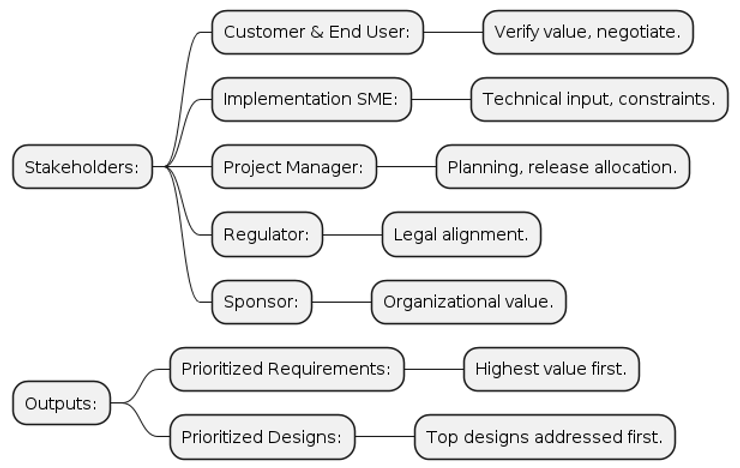Purpose:
-
Rank requirements by importance
Description:
-
Prioritize to:
-
Rank by stakeholders' importance
-
Adjust as context changes
-
Identify inter-dependencies
-
Maximize value
-

Inputs
-
Requirements: Text, matrices, or diagrams ready for prioritization.
-
Designs: Text, prototypes, or diagrams ready for prioritization.
Elements
-
2.1 Basis for Prioritization
-
Stakeholder Agreement: Agreement on prioritization basis defined by relevant stakeholders.
-
Factors Influencing Prioritization:
-
Benefit: Advantage to stakeholders from requirement implementation.
-
Penalty: Consequences of not implementing a requirement.
-
Cost: Effort and resources needed for implementation.
-
Risk: Chance of requirement not delivering value or not being met.
-
Dependencies: Relationships between requirements.
-
Time Sensitivity: Value decay after a certain period.
-
Stability: Likelihood of requirement change.
-
Regulatory or Policy Compliance: Requirements for meeting regulations or policies.
-
-
-
2.2 Challenges of Prioritization
-
Stakeholder Conflict: Different values leading to conflicts.
-
Difficulty in Lower Prioritization: Stakeholders finding it hard to characterize a requirement as lower priority.
-
Influence on Outcome: Stakeholders intentionally or unintentionally influencing prioritization.
-
Trade-offs: Necessary trade-offs due to conflicting requirements.
-
-
2.3 Continual Prioritization
-
Shifts in Priorities: Evolving context leading to shifting priorities.
-
Refinement of Requirements: Prioritization at a more granular level as requirements are refined.
-
Changing Basis for Prioritization: Different bases for prioritization at various stages of the change process.
-

Guidelines and Tools:
-
Business Constraints: Regulatory, contractual, and policy influences.
-
Change Strategy: Cost, timeline, and value considerations.
-
Domain Knowledge: Business domain expertise for prioritization.
-
Governance Approach: Defining prioritization methods.
-
Requirements Architecture: Understanding requirement relationships.
-
Requirements Management Tools: Prioritization attributes aid sorting.
-
Solution Scope: Managing scope during prioritization.
Techniques:
-
Backlog Management: Centralized prioritization location.
-
Business Cases: Aligning requirements with business goals.
-
Decision Analysis: Identifying high-value requirements.
-
Estimation: Providing basis for prioritization.
-
Financial Analysis: Assessing financial value and timing.
-
Interviews: Understanding stakeholder priorities.
-
Item Tracking: Recording stakeholder issues.
-
Prioritization: Facilitating prioritization process.
-
Risk Analysis: Understanding risks for prioritization.
-
Workshops: Group setting for stakeholder priorities.

Stakeholders:
-
Customer & End User: Verify value, negotiate.
-
Implementation SME: Technical input, constraints.
-
Project Manager: Planning, release allocation.
-
Regulator: Legal alignment.
-
Sponsor: Organizational value.
Outputs:
-
Prioritized Requirements: Highest value first.
-
Prioritized Designs: Top designs addressed first.



